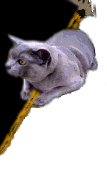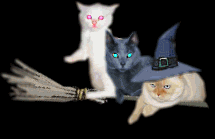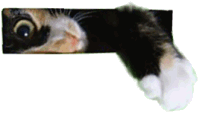Cats and the Devil

Q. w't other Creatures did you see?
A. I saw 2 Catts, one Red, another black as bigge as a little dogge.
Q. w't did these Catts doe?
A. I dont know; I have seen them two tymes.
Q. w't did they say?
A. thay say serve them.
Q. when did you see them?
A. I saw them last night.
Q. did they doe any hurt to you or threaten you?
A. they did scratch me.
Q. when?
A. after prayer; and scratched mee, because I would not serve them
Evidence of Tituba at the Salem Witch trials 1692
We have all seen the pictures of the witch's cat. Yet what makes a cute picture today reflects a popular superstition that led to cats being killed in the tens of thousands during the Middle Ages and the Renaissance. How did cats come to be associated with the devil? What exactly did people think that harmless old lady's moggy was up to?
Cats entered the Middle Ages at a certain disadvantage. The church was determined to eliminate paganism from Europe, and the gods of older religions became the devils and demons of the new. Cats had a respected place in the Egyptian pantheon, and also featured in Norse mythology; furthermore many cultures associated cats, especially black cats, with good luck. Even today, in different European cultures whether a black cat is regarded as good luck or bad luck depends how effective the church was at changing popular superstition. It did not help that cats are indeed creatures of the dark, in that they are naturally nocturnal. Anyone who has heard the unearthly midnight howling of a cat on the prowl might understand where the idea of demonic posession came from, and a distressed cat (and most of their persecutors saw them when they were distressed) can certainly look diabolical. Add to this a cat's natural stand-offishness, and the fact that there is something slightly wild and mysterious about even the most domesticated of moggies, and all the ingredients for persecution by the superstitious and credulous were in place.

Problems began in earnest in the 12th century when the church turned on heretics known as the Albigensians. It was alleged that they worshipped the devil, who appeared to them at Sataninc masses in the form of a black cat whose backside his followers were required to kiss. Some theologians claimed this as the origin of the alternative name for Albigensians - Cathars (Cat + arse) - although in fact the word comes from the Greek meaning "purified". This idea merged with another, the concept of a 'familiar'; a supernatural being who shared the household with the devil-worshipper. This was again, a perversion of the old Roman worship of a household's guiding spirits, the lares and penates.
The familiar was an imp given to the witch by Satan as her partner in evil. In popular superstition familiars could take many shapes. Dogs were occasional choices - for much of his career the infamous magic user Cornelius Agrippa was invariably accompanied by a large black dog. Toads were another favourite, especially as they were believed to posess magical powers (some toad skins sweat a hallucogenic compound, which might have helped with this belief), but as anyone keeping a pet toad would be regarded as somewhat odd even today, popular imagination focused on the cat.
A cavern. In the middle, a boiling cauldron. Thunder.
Enter the three Witches.
First witch. "Thrice the brinded cat hath mew'd..."
MacBeth Act 4 Scene 1
A witch's cat came to be called a grimalkin. The Scottish goddess of witches was called Mither o' the Mawkins, a 'mawkin' being a small animal - usually a cat or a hare.

Eventually the connection between cats and witches was so close that Pope Innocent VIII issued a decree in 1484 which pronounced cats as unholy creatures. He ordered that whenever a person was condemned as a witch, the cat should be burned as well as its owner. Not surprisingly,
cat ownership declined - indeed, as late as 1600, witchfinder's manuals agreed that ownership of a cat was one of the distinguishing marks of a witch. Since over 200,000 people died in as a result of this lethal stupidity, it is no surprise that many sensible people decided that doing without a cat was vastly preferable to falling under suspicion.
Feral populations of cats fared no better, as these were trapped and burned, hundreds at a time. The French witch finder Nicholas Remy wrote in his book Three works on the idolization of demons that not only could demons appear as cats, but that cats were basically demons. No-one knows how many thousands of cats were killed, but certainly the cat population of Europe decined sharply.
One power granted to witches by the devil was the power of revenge. A vindictive witch was said to be able to devastate entire tracts of country. Interestingly, the period between 1300 and 1700 represents both the period of the persecution of witches and their cats, and the time when Europe was wracked by successive plagues. The worst of these was the Black Death which, by some estimates, killed one out of every four people in Europe. Like many of the diseases which swept across Europe, the black death was carried by vermin, in this case the black rat. ("Millions of people in Europe died from plague in the Middle Ages, when human homes and places of work were inhabited by flea-infested rats." Unitied States Center for Disease Control)
Naturally, one of the best forms of protection against disease-spreading vermin was the common domestic cat. Except thanks to stupidity, superstition and religious fanaticism, the cat was not so common any more. Whether or not they were demons, one suspects the ghosts of the murdered cats might have taken a certain vindictive satisfaction from the result.
Cats on broomsticks were kindly provided by Pam Philp: Avenel Gallery

